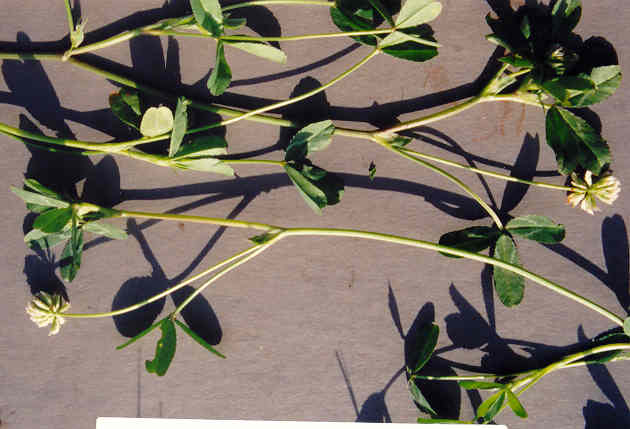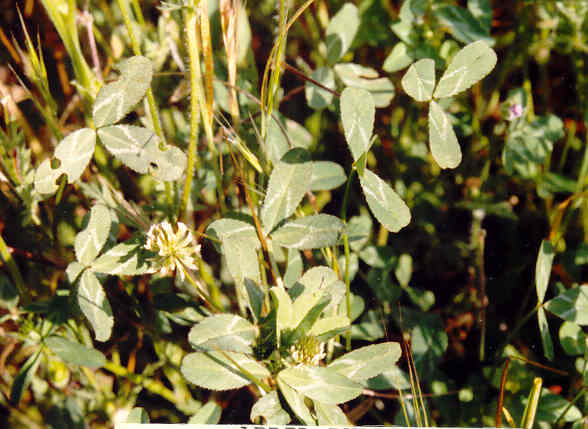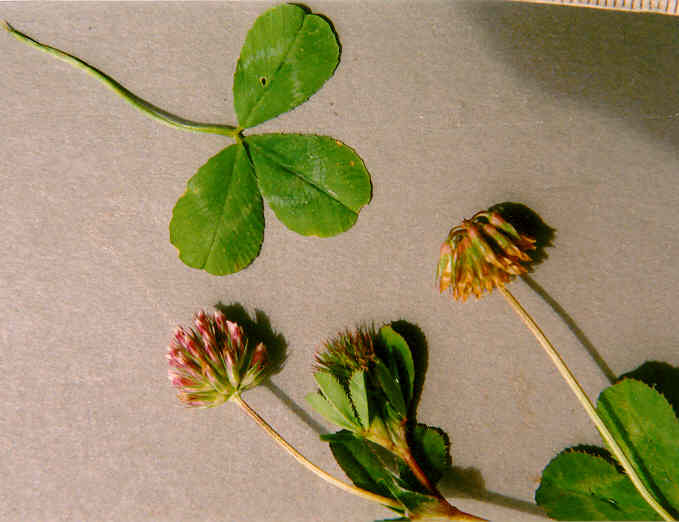
Trifolium gracilentum Torrey & A. Gray var. gracilentum
=Trifolium gracilentum var. inconspicuum
 |
Trifolium gracilentum Torrey & A. Gray var. gracilentum
=Trifolium gracilentum var. inconspicuum
Fabaceae (Pea Family)NativePin-point Clover |
April Photo
Plant Characteristics:
Annual, glabrous, the stems slender, erect or spreading, 1-5 dm. long;
lvs. long-petioled, 2-7 cm. long; stipules 10-15 mm. long, ovate-lanceolate,
membranous; leaflets 6-15 mm. long, obovate, serrulate, the serrations not
setaceous, emarginate at the apex; heads long-peduncled, globose or short ovoid,
6-10 mm. long; pedicels 1-2 mm. long; flowers reflexed in age, the rachis
projecting; calyx-teeth longer than the tube, subulate, entire, the margins not
ciliate; corolla 5-6 mm. long, well exceeding the calyx, reddish purple or light
pink; pod 1-2 seeded.
Our local plants have a corolla shorter than or equaling the calyx and
were called Trifolium gracilentum var. inconspicuum.
The 1993 Jepson Manual indicates that var. inconspicuum
Fern is not recognized and is now included in var. gracilentum.
Abrams, Vol. II page 524 says that this form of the species is found in
central and southern California.
Habitat:
Common in open grassy places; below 5000 ft.; V. Grassland, Chaparral, S.
Oak Wd., etc.; cismontane and occasional along w. edges of deserts; to B.C., L.
Calif. April-June.
Name:
Latin, tres, three, and folium, leaf. (Munz, Flora
So. Calif. 470. Latin, gracilis,
slender, thin. (Jaeger 112, Simpson 266). Gracilentum,
referring to the slender petioles. (my
comment).
General:
Rare in the study area as it occurs on only one small site on the bluff
top southerly of San Joaquin Hills Rd. and northerly of the Newporter Canyon.
This location was probably destroyed when the site was graded for houses in
1997. Found again in 2005, on the westerly side of the bay,
beside the bluff top walking path, roughly half way between the Interpretive
Center and 23rd St. See my comments with Plant Characteristics about the local
plants. (my comments).
The Cahuilla, Indians of the San Bernardino and San Jacinto Mountains and
the Colorado Desert, prepared clover by placing it between large heated stones. Sometimes onions and common greens were added.
The Cahuilla name for clover is derived from the Spanish word for clover,
trebol.
(Bean and Saubel 142).
Indians ate it raw or steamed and the steamed plant was dried for winter
use. White clover, T.
repens was eaten raw, both flowers and leaves, but if too much was consumed,
it would produce bloat, and, to counteract this effect, the leaves were dipped
in salted water. (Sweet 43).
Text Ref:
Abrams, Vol. II 524; Hickman, Ed. 652; Munz, Flora
So. Calif. 473.
Photo Ref:
April-May 92 # 8,9,10; April-May 05 #8.
Identity: by R. De Ruff,
confirmed by John Johnson.
First Found: April 1992.
Computer Ref: Plant Data 432.
Have plant specimen.
Last edit 6/12/05.
 |
 |
.